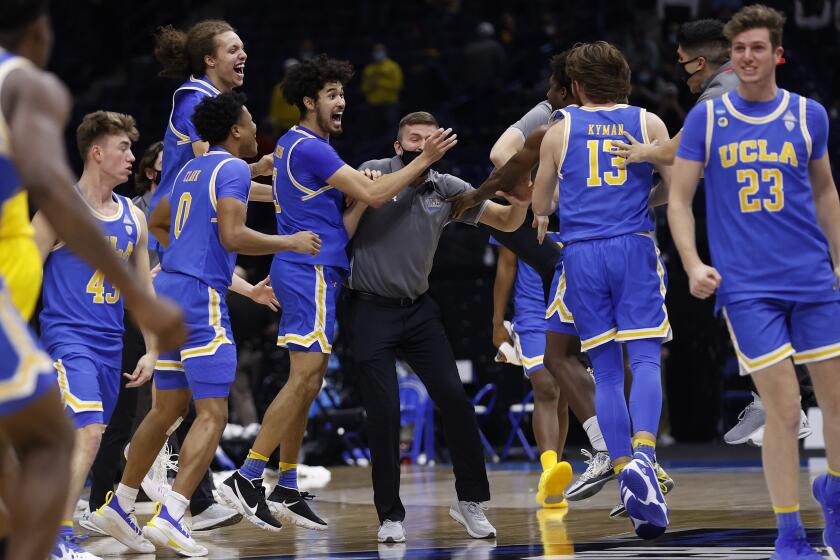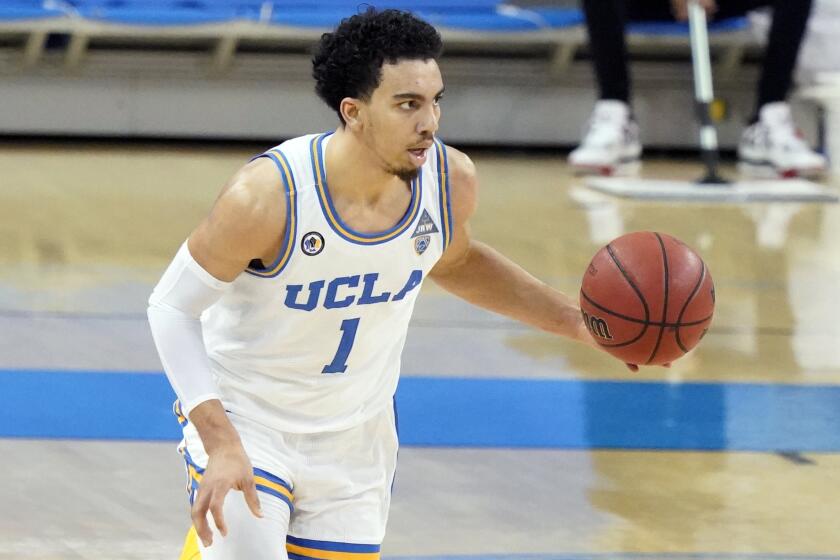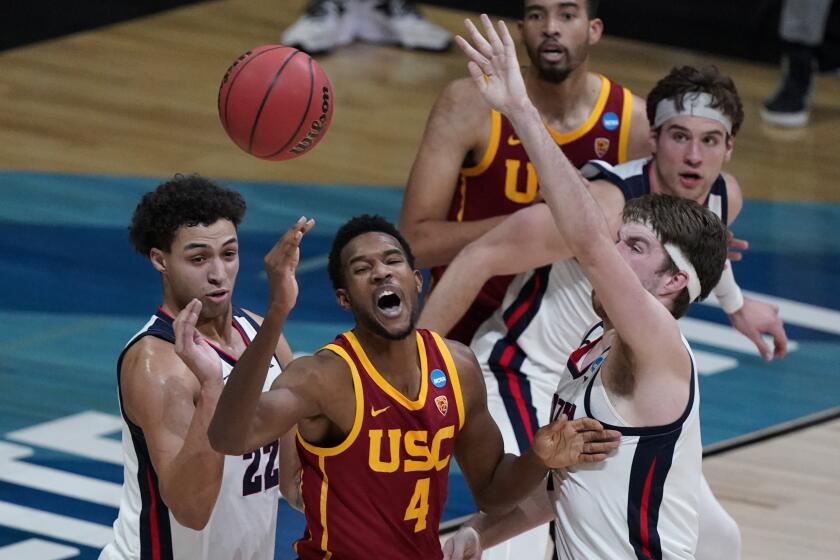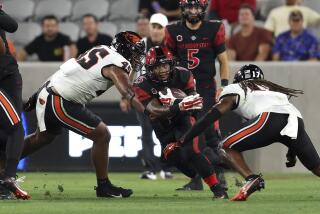How NCAA units turn the Pac-12’s March Madness wins into big paydays
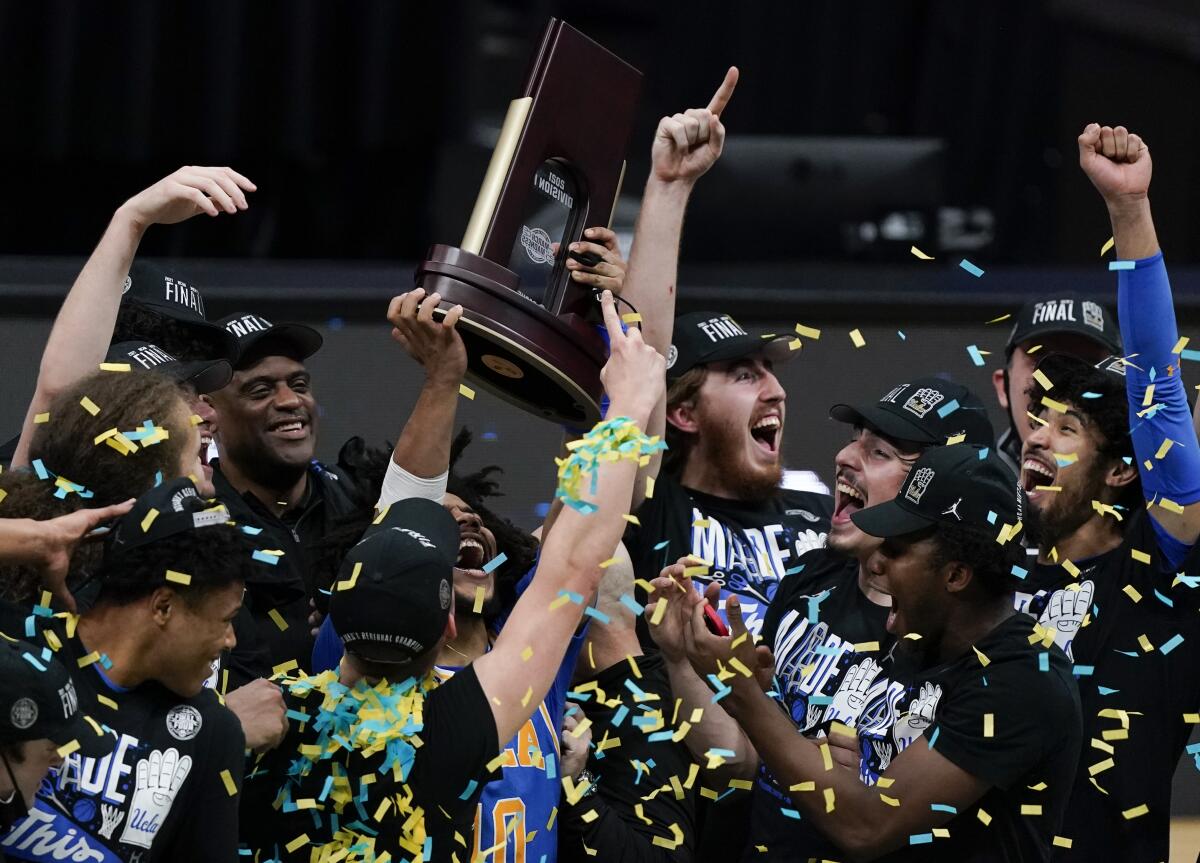
Confetti floated through the air at Lucas Oil Stadium after UCLA’s upset of No. 1 seed Michigan on Tuesday. It marked UCLA’s first trip to the Final Four since 2008, but to some cash-starved administrators in the Pac-12, the flying strips of paper could have just as easily symbolized the money that will soon pour into the conference.
With UCLA in the Final Four, the Pac-12 is having its most successful — and profitable — March Madness run ever. Five teams made the tournament and three, USC, UCLA and Oregon, advanced to the regional finals. Each game along the way racked up a “unit” for the Pac-12, 19 in total. It’s the most for the conference in a single tournament, which means a big paycheck for the athletic departments of each school in the Pac-12 for years to come.
How do wins on the court turn into money in the bank? Here’s a look at the system.
So what’s a unit?
The unit is like a redeemable token representing a game played in the NCAA men’s basketball tournament. Conferences cash in the units from one of two sources. The Equal Conference Fund covers each team’s first appearance in the tournament. Then when a team advances, the Basketball Performance Fund takes over and awards units based on a team’s performance. One game played equals one unit that goes to the conference.
The 11th-seeded Bruins answered the call of UCLA basketball history by charging back to the Final Four with a 51-49 victory over top-seeded Michigan.
UCLA, a First Four team that appeared in the extra play-in game, took the longest road possible to the Final Four and thus earned the maximum six units. (Units aren’t awarded for the national championship game.) Regional finalists USC and Oregon State each earned four units. Although its first-round game against Virginia Commonwealth was declared a no-contest after the Rams withdrew because of COVID-19 protocol, Oregon still collected the full three units from advancing to a regional semifinal. Colorado added two units.
How much is a unit worth?
The exact value changes each year, typically growing by a small percentage. In 2021, a unit equates to $337,141, but because the NCAA distributes the money to conferences over a six-year rolling period, a single unit gets multiplied into millions of dollars.
For instance, consider a game played in 2016. It is paid to the conference for six years, starting in 2017, with each payment changing based on that year’s unit value. Using numbers provided by the NCAA and previous reports, that 2016 win equaled $266,184 in 2017, $273,500 in 2018, $289,300 in 2019, $337,141 in 2021 and a projected $338,887 in 2022. Because of the pandemic, 2020 units were paid out differently: $279,334 for the first unit from a school in a single tournament and $87,673 for each unit following.
Add that together and a first-round appearance in 2016 turned into $1,784,346 for Pac-12 schools over six years.
With the Pac-12’s 11 units from seven teams in 2016, that one tournament will turn into a total six-year payout of $18,762,162 by 2022.
The 19 units from this year’s tournament will be paid out starting in 2022 in the period that includes units from 2021-2016. In 2022, the conference stands to cash in on 53 units and at an estimated $338,887 a pop, that will be a nearly $18-million check.
How is the value of a unit determined?
A normal tournament has 132 units, 68 coming from the Equal Conference Fund that pays for appearing in the tournament and 64 coming from the Basketball Performance Fund that rewards teams that survive each round. That number is multiplied by the six years in the payment cycle and the resulting 792 is divided into the NCAA’s budget to determine the unit value. The budget is based on several factors, including TV, tickets and radio revenue.
But things won’t be normal for a few years after 2020. That year accounts for zero units for six payment cycles, so the total number of units is reduced to 660 until 2027. Fewer units temporarily increase each unit’s price, which is the reason why 2021’s value of $337,141 was so much larger than the $280,300 in 2019.
For the first time in the history of the NCAA men’s basketball tournament, all Final Four teams come from west of the Mississippi River.
The units for the 2022 distribution are even stranger because the Ivy League opted out of its season and got a waiver from the Equal Conference Fund so there is one extra unit (661 total) that factors into the 2022 unit value.
What do universities do with the money?
Once the NCAA distributes the money to conferences, leagues are encouraged, but not required, to share it equally among all member institutions. The Pac-12 is one of the leagues that follows the guidance, so even schools that don’t make the tournament benefit by backing the Pac.
The conference doesn’t earmark the money to be used for certain applications, like only putting it toward basketball, for instance, so schools can spend their share on anything from scholarships, facilities, coaches’ salaries or tutors for athletes.
In 2022, when the Pac-12 gets its nearly $18-million payday that includes this year’s tournament success, each school will have about $1.5 million.
What role does COVID-19 play in this?
The conference’s magical March couldn’t have come at a better time. The pandemic devastated athletic department budgets across the nation and for Pac-12 schools weighed down by a lagging TV contract, long-awaited success in a revenue sport is a major boost while the conference waits for a new TV deal in 2024.
“It’s going to require some patience until that’s done,” Pac-12 commissioner Larry Scott said last week. “So in the interim, growth in revenue from other sources like March Madness will be very helpful and very appreciated by all the schools who share equally.”
USC coach Andy Enfield knew what was coming but failed to prepare his team for one of the most important games in program history.
What about the NCAA women’s tournament?
For all of the excitement about the Pac-12’s success in the men’s tournament, the conference is doing even better on the women’s side. Two Pac-12 teams, No. 1 seed Stanford and No. 3 seed Arizona, made it to the Final Four in San Antonio.
This year’s women’s tournament had unprecedented TV coverage with all games on ESPN networks, but still, it does not carry the same financial impact as the men’s tournament.
While interest in the women’s game is growing, the women’s tournament doesn’t turn a profit and the NCAA does not factor it into the financial distribution plan as it does for men.
Times staff writer Ben Bolch contributed to this story.
More to Read
Go beyond the scoreboard
Get the latest on L.A.'s teams in the daily Sports Report newsletter.
You may occasionally receive promotional content from the Los Angeles Times.

